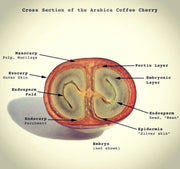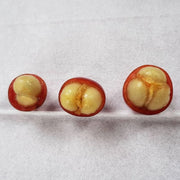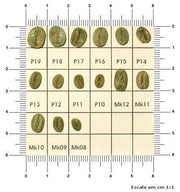Each coffee plant variety will have its unique flavor and depend on where the coffee is grown.
Flavors from each coffee variety
We will describe the basic Liberica variety first because this is the least exciting variety. This variety has huge stems, leaves, and fruits but low yields. Or planted as a windbreak for other coffee varieties.It has also been used as a genetic source to breed several coffee varieties that are resistant to increasingly harsh weather in recent years. Liberia’s sour taste is quite similar to that of ripe jackfruit.
The Robusta variety is suitable for growing under 1000m. The seeds are tiny compared to the Arabica variety, with good yield and high caffeine content (caffeine is an insect repellent, but the diverse insect environment is below 1000m).
Taste: bolder, more bitter, and sour than Arabica (additional: many of you wonder why I record that Robusta is more acidic than Arabica, this is only true when Robusta is lightly roasted because Robusta is grown at a low altitude, so it’s true. Sugar compounds and organic acids are less leading to a very sharp sour taste, not as delicate as Arabica); This is also the reason why people will often see Robusta beans or dark roast because if they are lightly roasted, they will have a sour taste like eating a whole lemon or drinking vinegar water.
On the other hand, Arabica is the opposite; the popular planting height is over 1000m, low yield, low caffeine content compared to Robusta, and poor resistance to pests and diseases.
Taste: aromatic, sour, mildly bitter, less intense than Robusta.
The general conclusion between Arabica and Robusta: in terms of quality, Arabica is better than Robusta, and in terms of output, Robusta will be higher due to its good yield. So the price of Arabica will be much more eye-catching than Robusta.
Depending on each person’s preferences, those who like aromatic, tea-like varieties should choose Arabica, and those who want bitter, strong drinks with sugar or condensed milk should use Robusta.
Flavors from each growing region
The coffee flavor will have common characteristics according to each continent globally, but there will still be exceptions. I temporarily divided into three continents with the following typical flavors:
- + Central and South America: balance flavor, mild acidity, spice, nuts like chestnut, almond, …
- + Africa region: bright acidity, fruity, medium body.
- + Asia region: earthy smell (earthy), sweet taste (sweet), thick body (heavy body).

(The flavors I just listed above are correct in most cases, everyone, there will still be countries and regions within that country that fall outside the above rule. The more you buy coffee, the more you will know the flavor of that region.)Personal conclusion: How well I know where coffee is grown will help me buy coffee beans with my favorite flavor or give some advice to customers. So if you like strong coffee, choose the right place to grow it, and don’t waste your time arguing with people who drink light coffee because there’s no such thing as a good rule here, just like it or not…
Fruit structure and green coffee beans
Regular coffee fruit comprises two main parts: the outer skin + mucilage, also known as the pulp (pulp/mucilage), and the seed part, including the husk/parchment. , silk skin (silver skin) and kernel (seed)

The mucilage or pulp (pulp/mucilage) is essential in creating flavor during preliminary processing. In contrast, the husk/parchment plays a role in preserving the beans—coffee for longer.A typical coffee fruit, if grown commonly, will produce two kernels, while a mutant will create a single peaberry coffee, and three (triangle) seeds.

An unconfirmed belief is that the single bean will give a fuller flavor, while in another coffee-growing country, this is seen as a bug that needs to be eliminated.
Each green bean in a variety and from each coffee variety will have a different size, so sieving is needed. The purpose is to make roasting coffee easier because of the amount of heat transferred to each coffee bean. The green kernel will be uniform and hit the user’s psychology when buying a product (big and even, it’s good to see).
Depending on the country, there will be a different way of classifying sizes/sieves by numbers or letters, and the ordinary standard people will use numbers, for example:
S16, here S is screen size or sieve; one sieve will have many holes, the diameter of each hole in the sieve is 1/64 inch, so S16 means 16/64 inch you will get green kernel size.

P here is the Pacas grain, and Mk is the Moka grain and the number is the sieve size. For example, Mk12 means Moka grain with sieve S12.
The Peaberry beans refer to the shape of the coffee bean, not about the flavor characteristics of a coffee or a coffee plant variety. Arabica or Robusta all have Peaberry beans.
Side knowledge: in Vietnam, we often confuse coffee beans grown in Moka and other beans like Robusta with a small sieve size similar to Moka beans. Most sellers name it Moka, but it’s just Robusta coffee with a small sieve size.









